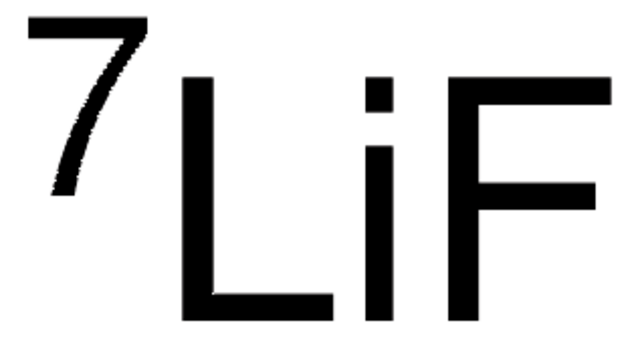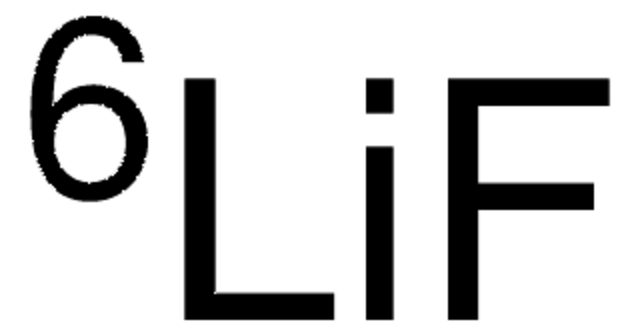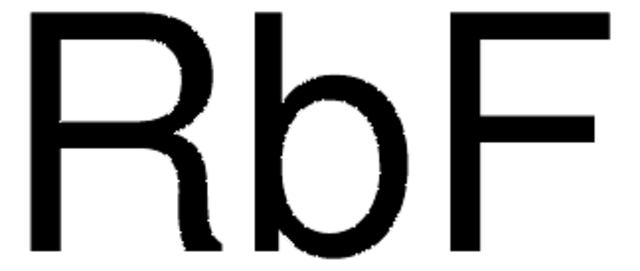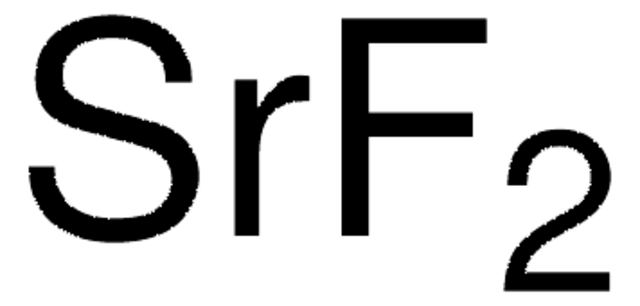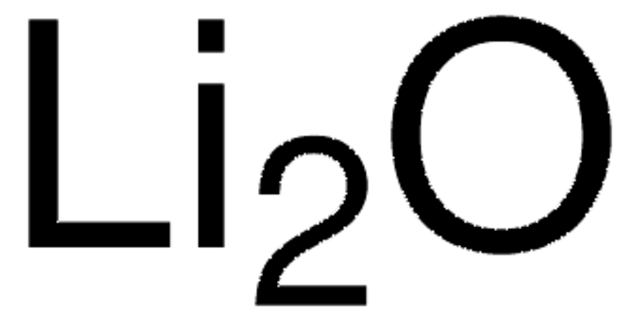Kluczowe dokumenty
449903
Lithium fluoride
≥99.99% trace metals basis
Synonim(y):
Fluorolithium
About This Item
Polecane produkty
klasa czystości
anhydrous
Próba
≥99.99% trace metals basis
Formularz
powder and chunks
charakterystyka ekologicznej alternatywy
Design for Energy Efficiency
Learn more about the Principles of Green Chemistry.
sustainability
Greener Alternative Product
zanieczyszczenia
≤100.0 ppm Trace Metal Analysis
bp
1673 °C/1 atm (lit.)
mp
845 °C (lit.)
rozpuszczalność
aqueous acid: slightly soluble(lit.)
gęstość
2.64 g/mL at 25 °C (lit.)
kategoria ekologicznej alternatywy
ciąg SMILES
[Li+].[F-]
InChI
1S/FH.Li/h1H;/q;+1/p-1
Klucz InChI
PQXKHYXIUOZZFA-UHFFFAOYSA-M
Szukasz podobnych produktów? Odwiedź Przewodnik dotyczący porównywania produktów
Opis ogólny
Zastosowanie
- As an additive to fabricate SiO@C/graphite composite anode materials for Li-ion batteries. LiF stabilizes solid electrolyte interphase (SEI) and enhances initial coulombic efficiency.
- As a critical component in SEI for stabilizing the SEI layer and improving the cycling efficiency of Li metal batteries.
- To fabricate electron contacts for high-efficiency n-type crystalline silicon solar cells.
- To prepare solid-state light sources for radiation imaging detectors.
- To synthesize highly crystalline MXene for asymmetric supercapacitor applications. And also, lightweight, flexible, and hydrophobic MXene foam with reasonable strength, high electrical conductivity, and an outstanding EMI-shielding performance.
- As an electron-injection layer to fabricate ITO/PEDOT:PSS/perovskite/B3PYMPM/ LiF/Al OLED device with a quantum efficiency of 20%.
Hasło ostrzegawcze
Warning
Zwroty wskazujące rodzaj zagrożenia
Zwroty wskazujące środki ostrożności
Klasyfikacja zagrożeń
Acute Tox. 4 Oral - Eye Irrit. 2
Zagrożenia dodatkowe
Kod klasy składowania
6.1D - Non-combustible acute toxic Cat.3 / toxic hazardous materials or hazardous materials causing chronic effects
Klasa zagrożenia wodnego (WGK)
WGK 2
Temperatura zapłonu (°F)
Not applicable
Temperatura zapłonu (°C)
Not applicable
Środki ochrony indywidualnej
Eyeshields, Faceshields, Gloves, type P2 (EN 143) respirator cartridges
Wybierz jedną z najnowszych wersji:
Masz już ten produkt?
Dokumenty związane z niedawno zakupionymi produktami zostały zamieszczone w Bibliotece dokumentów.
Klienci oglądali również te produkty
Produkty
Profesor Gogotsi i dr Shuck przedstawiają MXeny: obiecującą rodzinę dwuwymiarowych materiałów o unikalnym połączeniu wysokiej przewodności, hydrofilowości i szerokiej możliwości dostrajania.
Professor Gogotsi and Dr. Shuck introduce MXenes: a promising family of two-dimensional materials with a unique combination of high conductivity, hydrophilicity, and extensive tunability.
Research and development of solid-state lithium fast-ion conductors is crucial because they can be potentially used as solid electrolytes in all-solid-state batteries, which may solve the safety and energy-density related issues of conventional lithium-ion batteries that use liquid (farmable organic) electrolytes.
Nasz zespół naukowców ma doświadczenie we wszystkich obszarach badań, w tym w naukach przyrodniczych, materiałoznawstwie, syntezie chemicznej, chromatografii, analityce i wielu innych dziedzinach.
Skontaktuj się z zespołem ds. pomocy technicznej
